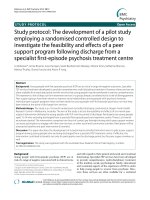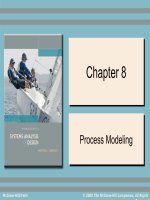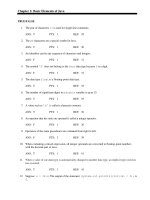Introduction to Computing: Lecture 8 - Dr. Pham Tran Vu
Bạn đang xem bản rút gọn của tài liệu. Xem và tải ngay bản đầy đủ của tài liệu tại đây (144.43 KB, 26 trang )
Introduction to Computing
Lectured by: Dr. Pham Tran Vu
1
Programming
- Programming languages
- Program design, testing, debugging and
documenting
- Data structures
2
Program Design
Computer programs need to be error free
and robust
Programs need to deal with not only correct
input data but also non-ideal data which is
subject to certain level of errors
Computer design and production is a very
skilled activity
3
Problem Solving
Understand the problem
Design a solution
Test the solution
Document the solution
4
Understand the Problem
Before a solution can be design, it is
necessary to thorough understand the
problem
E.g.
Write a program to read in a date and convert it
to the number of days from the start of the
calendar year
5
Design a Solution
Top-down stepwise refinement
Design the main module and the reduce it to
smaller, simpler and more manageable
components
Tools:
Structure chart
Pseudocode
6
Structure Chart
To provide a graphical representation of logical
structure of a program
E.g.: a program to calculate the sum of two
numbers
Total
Read a, b
Answer
=a+b
Display
Answer
7
Pseudocode
Code-like instructions to help program coding and
testing
Usually independent from programming languages
E.g.: a program to calculate the sum of two
numbers
1.
Read a, b
2.
Answer = a + b
3.
Display answer
8
Data Table
Define the purpose and type of variables
used in the solution
Name
Description
Type
Answer
Holds the sum of the
two numbers
Real number
a
First number entered
Real number
b
Second number
entered
Real number
9
Test the Solution
Use test data to step through the solution to
check if the solution is correctly design
10
Document the Solution
Documentation is important
Design document needs to include
The problem statement
The top-level program design
The final detail program design
The data table
11
Structured Programming
Most program design methodologies are based on
structured programming
Basic principles
Restricted use of control structures
Modularity
Top-down, stepwise refinement
Clear program format
Comments
Simplicity
12
Example
• Design a program
that reads in student
examination marks.
Each mar is to be
displayed as a grade
as follows:
Mark
Grade
80 or over
Distinction
60 or over
Merit
40 or over
Pass
Less than
40
Fail
13
Program Testing and Debugging
Errors always present when someone write a piece
of code
Two types of error:
Syntax errors
Logic errors
Debugging is the process of finding errors or bugs
Testing is the process of checking if the program is
working as it is designed to do
14
Debugging
Detecting syntax errors
Most of the developing environments have tool to check
for syntax errors
Detecting logic errors
This is a more challenging task
Approaches:
Talking with other about your solution
Using debugging code (print out variables’ values)
Using debugging facilities
15
Testing
To check for less obvious logic errors
Test data should be carefully chosen so that
Every statement is executed at least once
The effectiveness of every section of coding devoted to
detecting invalid input is verified
Every route in the program is tried at least once
The accuracy of the processing is verified
The program operates to according to its original design
specification
16
Test Data
Normal data
Most general data the program is designed to
handle
Extreme values
Boundary values of variables and inputs
Exceptional data
Unexpected data
17
Black Box Testing
To test functions of program in terms of
inputs and outputs
The whole function being tested is
considered as a black box
Usually used for boundary value analysis
18
White Box Testing (1)
The program code is thorough tested
White box testing focus
Covering multiple conditions in a program
Test data should cover all the possible conditions in
a program
19
White Box Testing (2)
Covering loops within program
Test data should cover the following
Going the loop at a minimum number of times
Executing the loop once
Executing the loop maximum number of times
Executing the loop one less than the maximum number
of times
Executing the loop several times
20
Validation
One the programmer is confident that the
program has sufficient testing and it will
behave according to the specification
without error, the program is then
transferred to expected users for validation
before final release
If the validation is failed, the program needs
to be modified and re-tested
21
Program Documentation
Design of a program needs to be carefully
documented so that other programmers can follow
the documentation to build or modify the program
Document checklist
Identification
General specification
User information
Program specification
22
Identification
Title of program
Short statement of its function
Author
Date written
Language used and its version
Hardware requirements
23
General Specification
Main actions of the program
File specifications
Restrictions and limitations
Equations used or text to explain complex
procedures/techniques
24
Program Specification
Structure charts, flowcharts, decision tables
Annotated listing
Testing procedure and test data
25









